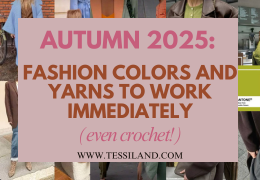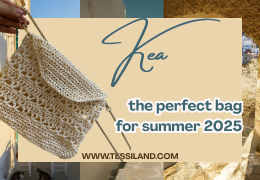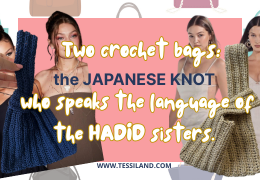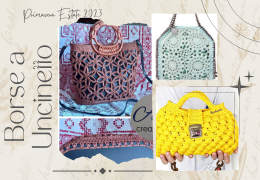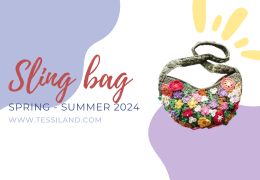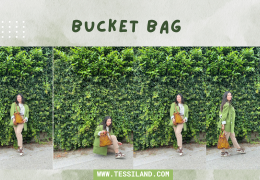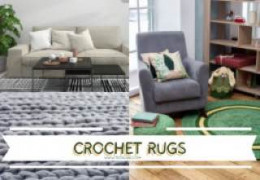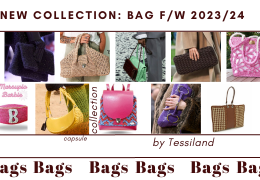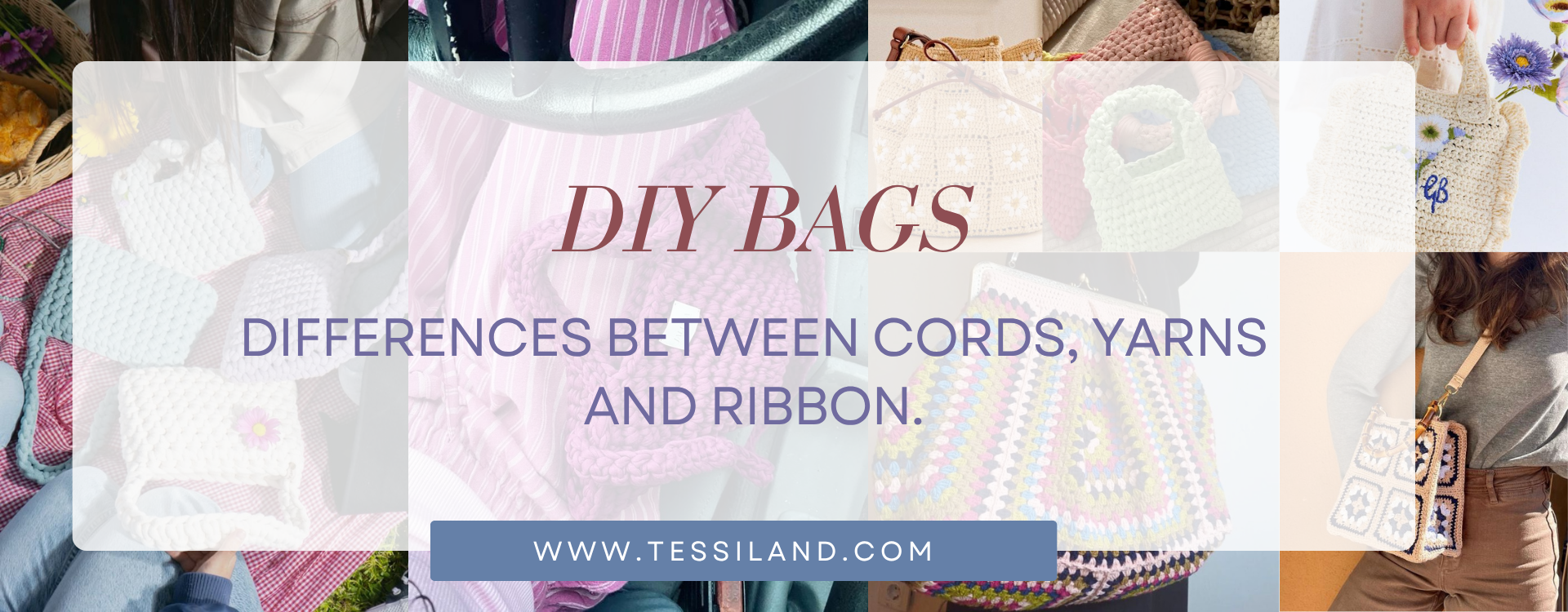September is the perfect month to rediscover your inspiration. In this article, you’ll uncover 5 habits that are...
DIY Crochet Bags: DIFFERENCES BETWEEN YARNS.
Before choosing the yarn… do you really know your fibers?
We’ve officially joined the crochet addicts club. It’s not (just) a passing trend, it’s a return to craftsmanship, slowness, and the “made with love” spirit. And if your Pinterest boards are filled with more crochet bags than Céline coats, then this weekly feature is for you.
Welcome to DIY CROCHET BAGS, the new series that will accompany you every week on your handmade bag journey. Because, my friends, making a bag by hand is not just about knowing how to single crochet. It’s design, style, materials, technique… and a good dose of the right questions.
And the first one to ask is: which yarn should I use?
Yarns: everything you need to know before choosing
The world of yarns can be as fascinating as a vintage market in Paris, but also as tricky as online sales with no returns. Not all yarns are suitable for a bag, and no: picking “the cutest one” is not enough.
JUTE, RAFFIA, LYCRA RIBBON YARN: LET’S CLARIFY
Three yarns, three worlds. Here’s what sets them apart (and how to make the most of them for your handmade bags).
JUTE
Creative idea by Fata Tuttofare:
Origin: Natural fiber obtained from the Corchorus plant.
Appearance: Raw, matte, with a sandy or natural beige color.
Feel: Rough, substantial, stiff.
Performance: Very structured, holds its shape well.
Ideal for:
- Beach bags, rustic shoppers, summer buckets
- Boho, country, and ethno-chic styles
Tip: Best used with metal or sturdy ergonomic hooks. Perfect for bags that don’t need lining.
NATURAL RAFFIA
Creative idea by Angolo di Criss:
Origin: Derived from the leaves of the Raphia palm, it’s a 100% plant-based fiber.
Appearance: Thin, slightly shiny, woven straw effect.
Feel: Light, stiff but more flexible than jute.
Performance: Instant holiday vibe: gives that “chic straw bag” effect right away.
Ideal for:
- Summer hats and bags, clutches and day handbags
- Gipsy, safari or resort mood
Tip: Work with care and properly sized hooks. Best used with simple or semi-rigid patterns.
LYCRA RIBBON YARN
A creative, trendy idea right now, by Angolo di Criss:
Origin: Synthetic elastic fabric, often made from textile production scraps (creative recycling).
Appearance: Shiny, colorful, “stretch fabric” effect.
Feel: Soft, fluid, elastic.
Performance: Softness and volume, ideal for quick projects and sporty or casual designs.
Ideal for:
- Backpacks, soft bags, oversized shoulder bags
- Urban, streetwear, pop mood
Tip: Use large hooks (size 8-10) and relaxed hands. Perfect for daily or gym bags.
| Feature | Jute | Natural Raffia | Lycra Ribbon Yarn |
| Origin | Natural (fiber) | Natural (leaf) | Fabric |
| Texture | Stiff | Stiff but light | Soft and elastic |
| Appearance | Raw matte | Plant-based shine | Shiny and colorful |
| Difficulty | Medium/High | Medium | Easy |
| Ideal Style | Country/Boho | Summer/Chic | Urban/Pop |
| Recommended Hook | Sturdy Ergonomic | Medium Size (4-6) | Large (8-10) |
Guide to cords for handmade bags: which one to choose?
.png)
Absolutely! Here is an expanded and narrative version of the paragraph dedicated to cords, designed to serve as the central section of an article (magazine or blog) or as an introduction to a guide, maintaining an engaging and informative style: Cords: the soul of your bag.
When it comes to handmade bags, the cord is the starting point, the heart of the project, the element that defines style, shape, strength, and identity. It’s not just a matter of taste or color: it’s the raw material with which we shape our accessory, the textile voice that expresses our creative idea.
But the world of cords is far from all the same. On the contrary, it’s vast, layered, technical, and fascinating.
For beginners?
Thai Sublime is the most loved choice: it’s soft to the touch, easy to work even with basic stitches like single crochet or basketweave, and it holds its shape perfectly, meaning your bag won’t need reinforcement or structure right away. Available in solid colors, gradients, and also in a lamé version (Thai Sublimelux), it’s ideal for both beginners and for creating trendy, professional projects.
Looking for structure and presence?
SuperThai is the gentle giant: thick, visually impactful, perfect for maxibags, storage baskets, and even rugs. It works well with large hooks and gives you impressive results with just a few stitches.
Looking for an elegant and refined effect?
Thai Skinny, the thinnest of all, was born to highlight stitch definition. Picture it on an evening bag made with popcorn stitch or on a clutch with geometric patterns: crisp details, precious texture, couture result.
Love versatility?
Thai Slim is the ultimate “go-to” cord. It sits right between Sublime and Skinny, but stands out for adaptability and performance. Great for bags, party favors, plant holders, and accessories. Also available in gradient versions—perfect for modern color effects.
On a budget but don’t want to sacrifice style?
Thai Lurex is a great compromise: affordable, available in many variations, enhanced with a lurex thread that adds sparkle. It’s perfect for batch projects like party favors, gift clutches, or small Christmas creations. One tip: since it’s a best-seller, dye lots change often, so pay close attention to the color code!
Mouse tail effect but at an affordable price?
Rowen is the smart alternative: shiny, thin, very elegant. Great for compact bags, crossbodies, and small clutches. It gives you that “urban fashion” look without needing to use the more expensive classic materials.
Have a rustic soul or love country style?
Then Ternes and Tornado are made for you. Both are cotton blends, matte, soft, and natural to the touch. Ternes is thicker, ideal for shabby chic-style bags, curtains, rugs, and macramé-style cushions. Tornado, on the other hand, is its thinner and more defined version, perfect for more intricate or refined projects.
And for winter?
Freddy is the wool-look cord that saves your season. It combines the visual warmth of wool with a compact structure that makes it durable, professional, and long-lasting. Bags made with Freddy won’t felt or lose their shape: a smart choice for boho-chic winter accessories.
The most creative of all?
Chobin. Tubular, elastic, futuristic. Not just for bags: Chobin lends itself to artistic projects, sculptural creations, branches, stylized flowers, and 3D shapes. It can even be filled with an internal core (metal, plastic…) to create structures that look like they came straight out of a design exhibition.
And finally, an explosion of cord!
Thanks to its compact structure and quality materials, Olly cord is perfect for a wide range of applications. Whether you want to create bags, baskets, rugs, or home decorations, this yarn guarantees outstanding results. It’s also ideal for macramé lovers, offering excellent knot hold and a refined aesthetic effect.
Each cord has a personality, and every bag you create tells a piece of your style and craftsmanship. Choosing the right one is not just a technical decision—it’s an act of artistry.
Discover all the differences between Tessiland’s main yarns: from those perfect for beginners to the most technical and stylish options.
PART 1:
| Yarn Name | Features | Hook Size | Ideal for | Notes |
|
Thai Sublime Thai SublimeGradient Thai SublimeLux |
Soft, easy to work with, even texture |
3-4 |
Bags for beginners, ongoing projects. |
Available in 3 variants |
| SuperThai |
The thickest in the range, very structured |
4-5 | Maxibags, rugs, baskets | Volume and WOW effect |
| Thai Skinny |
The thinnest of the Thai line, elegant and precise |
2-3 | Bags with bubble stitches | Enhances stitch definition |
|
Thai Slim Thai SlimGradient |
Versatile, intermediate thickness |
2.5-3 | Bags, party favors, home decor | Available in 2 variants |
| Thai Lurex |
Affordable, with lurex |
3-4 | Party favors, bags | Watch out for changing dye lots |
PART 2:
| Rowen | Similar to classic mouse tail cord | 2-3 |
Compact bags, shiny finish |
Like traditional mouse tail cord, 100% Made in Italy |
| Ternes | Cotton blend, thick, matte | 7-8 |
Macramé, shabby bags, curtains, rugs |
Rustic and country look |
| Tornado |
Cotton blend, thinner than Ternes |
5-7 | Finer-style bags, detailed projects | Great for precise macramé work |
| Freddy | Wool-look cord | 7-8 | Winter bags | Does not wear out or shed fibers |
| Chobin |
Tubular, elastic, creative |
5-7 |
Artistic accessories, 3D shapes, decorative branches |
You can insert wire inside to create shaped designs |
| Olly | Cotton blend, circular, matte | 9-10 | Bags, baskets, accessories, home decor, macramé | Perfect for DIY and home decor lovers |
Which cord is perfect for you?
- If you're just starting out, choose Thai Sublime: it’s the perfect balance between softness and structure.
- For large bags and home accessories, go for SuperThai.
- Want elegance in the details? Thai Skinny is your secret weapon.
- For creativity and out-of-the-box shapes, Chobin is an extraordinary wildcard.
- Cold season coming? Freddy is your boho companion for winter.
Let’s start with the main differences to know before choosing.
Thickness
The thickness of the yarn determines the structure of the bag. The thicker and more compact it is (like cord or ribbon yarn), the more rigid and stable the bag will be. Yarns that are too thin? Great for aesthetics and detail work, but they will require reinforcement (bag bases, stiffeners, mesh…).
Use
Roomy shopper? Evening clutch? Summer mini bag? Every style has its ideal yarn.
Thai cord for structured, well-defined bags.
- Elastic ribbon yarn for soft clutches and fast projects.
- Chunky wool or structured acrylic for winter bags.
- Waxed or glossy cotton for micro bags and evening clutches.
Season
Just like fashion, crochet has its seasons too.
In summer, lightweight and colorful cottons dominate, while in winter, faux fur-effect yarns, bouclé wool, and glittery yarns come into play.
Origin and availability
Not all yarns are easy to find, and some (especially more technical or fashion-forward ones) need to be ordered online or sourced from specialized retailers. My advice? Choose brands that guarantee quality, traceability, and customer support. Even better if made in Italy.
Trend
Yes, yarns follow trends too. This year? Say yes to:
- sorbet shades
- mélange yarns
- lurex effects
- matte yarns with powdery texture
Crochet hooks: the right tool to start (and fall in love with handmade)
Who said all crochet hooks are the same?
Just like shoes, the difference between crocheting well and crocheting “meh” can all be in the grip.
And trust me: when you start making bags — especially with structured yarns like cords, ribbons, or raffia — having the right tool makes all the difference.
On the market you’ll find:
Classic aluminum hooks
Lightweight, affordable, perfect for beginners wanting to test different thicknesses. But watch out: they can tire your hand during longer sessions.
Ergonomic crochet hooks
The most recommended for those who crochet frequently and for long periods. The rubber or silicone non-slip handle makes the grip firm, comfortable, and… yes, fashion-friendly too. They’re perfect for cords, helping you manage strength without straining your fingers.
Bamboo or wooden crochet hooks
Visually stunning, eco-friendly, lightweight. Great for delicate projects or with natural yarns, though they tend to be “slower” since they don’t glide like metal. If you love meditative and relaxed crocheting, they’re a great choice.
But how do I choose the right size?
The hook size should always be matched to the yarn.
If you’re working with thick cords or ribbons, it’s best to use hooks between size 5 and 9 (depending on the thickness).
- A hook that’s too thin will make the work hard, the stitch too tight, and the fabric overly stiff.
- A hook that’s too big, on the other hand, will make the bag floppy and shapeless.
The golden rule?
Always test with a 10x10 cm swatch before starting the bag: it helps you see if the yarn and hook are a good match.
One more tip
If you’re planning to make more than one bag (spoiler: you will), consider investing in a set of ergonomic hooks in different sizes. Not only are they beautiful to look at (and perfect for Instagram photos), but they let you work with a variety of yarns and test stitches in total comfort.
And what about accessories?
We’ll talk about them in upcoming episodes, but for now, keep these essential terms in mind:
- Connectors: used to attach handles to the bag
- Eyelets: reinforce holes for chains, closures, decorations
- Bag base: the rigid base of the bag, can be made of leather, faux leather, or plastic. Not always needed, but sometimes… it’s a game changer.
This is just a quick overview. A guide to help you avoid falling into the trap of “I'll make a bag with whatever I have”.
Whether you’re a newbie with your first ball of yarn or a crochet queen with a thousand WIPs, choosing the right material is the first step toward a bag you’ll truly love.
In the next episode? We’ll talk about how to choose the perfect model for your style and skill level.
Because every bag tells a story… and yours deserves to be written well, stitch by stitch.
Follow me every week for new tips, projects, and advice from the DIY bag world. Because fashion — even handmade — has its rules. And we write them with a crochet hook in hand.
Rosaria Tessiland®
.jpg)


